 |
Traditionalist Issues
The Abomination of Desolation
in Machabees and in the Present
Fr. Stephen Somerville
Catholics often talk about the "end of the world". This has been so since the very time of Christ on earth. The disciples of Jesus once asked Him, "What shall be the sign of Thy coming and of the consummation (that is, the end) of the world?" (Matt 24:3) Every year in the Liturgy at the end of November, we hear readings at Mass about the end of the world, and the final coming of Christ.
So you see, our talking about the end of the world, although it may be frightening or mysterious, still it is not something unimportant or mistaken or superstitious. Notice that the disciples asked Jesus, not when will be the end, but what sign shall there be of Thy coming, and of the end of the world? For we know from Jesus that the day or the hour of the end is God's secret. But as for the signs of it, Jesus does speak abundantly, especially in the end-of-the-world discourse in the Matthew, Mark and Luke Gospels. We call this discourse eschatology, which means the study of the eschata, which is Greek for the Last Things. These are, in tradition, four things: Death, Judgment, Heaven, and Hell.
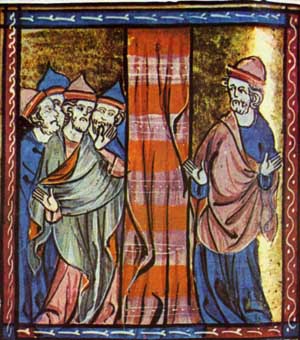
Above, the pagan King Antiochus boldly enters the sanctuary. Below, an unfaithful Jew comes to sacrifices to pagan gods at an altar
 |
One of the most significant signs of the end of the world will be the so-called abomination of desolation. Jesus himself says this in Matthew 24:15. He says that Prophet Daniel predicted the abomination of desolation and he adds, "He that readeth, let him understand."
This means that some of us must read Prophet Daniel, and also books I and 2 of the Machabees at the end of the Old Testament because these books also speak of the abomination actually happening, for example in I Machabees 6, verse 7.
There we read that the conquering faithful Jewish army had re-taken Jerusalem, and they had "thrown down the abomination from the altar" in the temple. These words indicate the abomination was some kind of pagan statue that the pagans and the pagan-minded, unfaithful Jews had set up on the holy Temple altar.
It also suggests what other Bible evidence shows, that the abomination or evil sacrilegious thing is the abolition, the doing away with, of the daily, holy sacrifice on the Temple altar, and the substitution of a false-god statue with some false sacrifice or worship, on the holy altar.
This would be a most grave mortal sin against the First Commandment, which says, "I am the Lord, thy God; thou shalt not have strange gods before me." In I Machabees, we read that the cruel pagan King Antiochus invaded Jerusalem, entered the holy Temple, stole or destroyed all the holy vessels for worship, and forbade the Jews to offer their usual sacrifices, holocausts and atonements. He also killed many of the Jews. So we read in I Mac 1:30 to 60.
Sacrificing upon the altar of the idol
King Antiochus, it is written further, and I quote verse 57, "set up the abominable idol of desolation upon the altar of God, and his soldiers built more such altars all around Judea." They also burned the holy books of the law of God, and any Jew found keeping such scriptural books was put to death. Then the writer tells us that "on the 25th day of the month, they sacrificed upon the altar of the idol that was over against the altar of God." (I Mac. 1:62).
I ask you to take note of those expressions: upon the altar and over against the altar. They suggest a practice in most Catholic churches since the 1960's where they still had retained the old high altar for the traditional Latin Mass. They constructed a new altar, usually table-like, and placed it in front of the old one, in the open sanctuary space. Looking at this new altar from the nave, we could say that it is over against the old altar, and is intended, not for the old Latin, Tridentine Mass, but for the new rite, or Novus Ordo Mass in English.
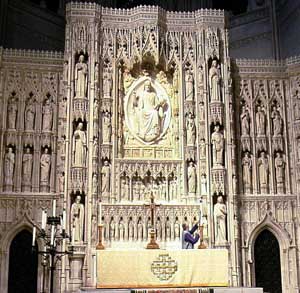
The first step was to place a table-altar in front of the old high altar. Later, there would be only the table - often modern and extravagent, below
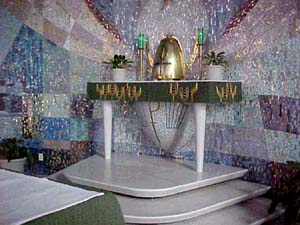 |
This arrangement is still the case in some major churches where the old high altar is a historic work of art, and must not be removed or changed. We see from these remarks the meaning of abomination. It is an evil pagan ceremony or statue or practice that disgracefully replaces the true and holy symbols and ceremonies of the true God. It is sacrilegious, that is, violating a sacred place or thing or person. It is also blasphemous, that is, offensive and contemptuous to God Himself.
The meaning of desolation
What then, does desolation mean? We read in 1 Mac 1:39 "(The enemy) defiled the holy place, the (faithful) inhabitants of Jerusalem fled away, and the (Temple) sanctuary was desolate like a wilderness." There we have it: desolation means being desolate, being abandoned by good people, and worse, being abandoned by God and by His grace. In the time of the Machabees, the Jewish people were tiring of their old religion; they were dabbling in paganism, and being attracted or deceived or forced into real apostasy, that is, the rejection of their religious Judaic Faith. They became idolaters, that is, worshippers of idols or false gods.
I hope my reader is patiently attending to all I say, to all these perhaps tedious details. Why pay attention? Because disasters and temptations similar to these which afflicted the Jews in the second century B.C. [Before Christ], could also afflict us Christians in a later period. Are such evils of apostasy and sacrilege affecting the Catholic world today? Does what I tell you of 2nd century B.C. Jerusalem make you think of late 20th century Catholicism?
Are we Catholics under severe political and popular cultural pressure to abandon the good traditional Catholic habits of up to the 1950's under Pope Pius XII? Is all this talk and promotion of ecumenism causing us to water down our Catholic firmness? Do we look benignly on the false and diabolical pagan religions? Do we smile at Islamism, which is so ambivalent and often cruel towards Christians? Do we favor Judaism, which stubbornly refuses, even after 2,000 years of holy Christian evidence, to recognize Jesus as Messiah? Do we encourage those Jewish leaders who keep suggesting the epithet anti-Semitic against Christians? Are the Jews doing this to distract public attention from their own stance, which may be truly anti-Christian?
We must also mention the secular leaders and spokesmen who strive to ban all talk of God from the public scene. They scoff at religious truth as being subjective and irrelevant in the public affairs of peoples. They make some mythical "Man" the be-all and the end-all of real life. They privately laugh at talk of Heaven and Hell, and life after death. All these foregoing pressures, policies and plans in the world around us are a real possible corruption and corrosion to our Catholic Faith. We, and especially our children, are likely to fall into various sins because of them, even if not outright apostasy.
Well, huge numbers of Jews at the time of the Machabees were doing just that. They discarded the laws of God; they took up idolatry and sacrilege in the then-current frenzy of ecumenism toward pagan ways. They were aiding and abetting the abomination of desolation in their midst, though possibly unawares. But it had been foretold by Prophet Daniel around 580 BC. We saw that Jesus credits Daniel for that prophecy.

Today we face an abomination of desolation on the altar and in the Church |
But Jesus also shows that there will be another abomination of desolation in the end times of the world. There may also have been partial abominations in the past Church History, such as the grievous Arian heresy in the fourth century, or the Protestant revolt in the 16th century. Some scholars think the Jews had a second abomination of desolation in the time of the revolt, 66 to 73 AD. This is not recorded in Scripture. But the abomination at the end times is indeed predicted in Scripture by Jesus Christ Himself, not to mention by St. Paul.
One thing that St. Paul does tell us is that Old Testament disasters and punishments upon the ancient Israelites or Jews were a sign and a lesson not only to them, but also to us Catholics of this new and present age. He writes to the Corinthian Christians about the sins and sufferings of the Israelites in their passage through the Red Sea and the Sinai desert toward the Promised Land. And he adds this comment for us:
"These (marvelous and grievous) things were done (to the Israelites) in a figure of us, that we should not covet evil things as they also coveted ... all these things happened to them in figure: and they are written for our correction, upon whom the end of the world (that is, the last times) are come. Wherefore, he that thinketh himself to stand, let him take heed lest he fall ... fly from the service of idols." (1 Cor 10: 6-14).
Fulfillment of the abomination of desolation in our times
The point for us to remember is the real correlation between Old and New Testaments in God's saving actions. One writer says it thus:
"Christ is saying, look for a hidden fulfillment or replication of the Old Testament abomination of desolation in these New Testament times. The end-time abomination will not replicate exactly the former one in every respect, but will so substantially resemble the former as to be recognizable to those who are looking with eyes of faith" (E. DeStafinis p. 2).
There is a particular point of resemblance between the Machabees abomination and a similar phenomenon in our own time. I underlined it earlier to you. It is the placing of a new altar upon the old altar of God or sanctuary, and placing it over against the old altar. This was common practice with us Catholics in the 1970's and 1980's. Since then the old altar has been demolished and removed in the great majority of Churches.
Now you know that some theologians maintain that the new Roman Catholic order of Mass is clearly invalid, or may well be so, because of changes in the words of the Consecration of the chalice.
Lesser reasons for concerns are the watering down of the Collect Prayers, the removal of dozens of signs of reverence for the sacramental Body and Blood of the Victim Christ, the near-abolition of the Roman Canon with its rich and emphatic doctrine of Sacrifice, the loss of most of the Offertory prayers, the banishment of Gregorian Chant, and the orientation of the priest toward the people and away from God. Such a diminished and gutted liturgy could well point toward an abomination prompted by some demon sent to misguide the reform committee.
St. Bridget of Sweden, who lived till 1373 and founded the Bridgettine Sisters, was famed for her heavenly messages and prophecies. She predicted in these words, "In the year 1980 the wicked will prevail. They will sacrilegiously profane and defile the churches by erecting in them altars to idols and to anti-Christ whom they will worship and attempt to force others to do the same."
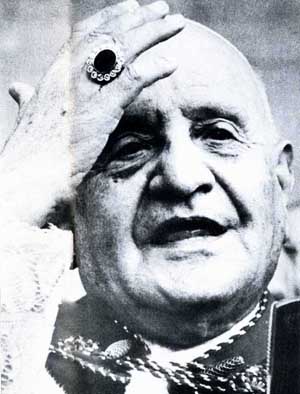
Is there a correlation between John XXIII and Jason "impious and no priest"?

Between Paul VI and Menelaus, who introduced the obligatory new "sacrifices"
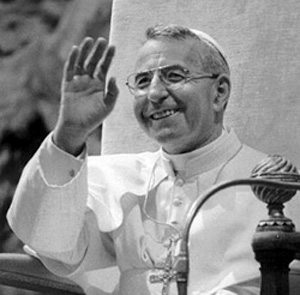
Between John Paul I and Lysimachus, who was killed "beside the treasury"
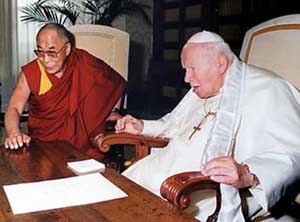
Between John Paul II and Alcimus, who "willfully defiled himself mingling with the heathens" |
St. Bridget says this will occur in 1980. Now it was December 1, 1974 when Pope Paul made the Novus Ordo Mass mandatory in its final form. But Jesus was probably born in 6 BC according to the best calculations. This would make 1974 become 1980. St Bridget seems to have been right on target.
Another significant point is that the Jews never allowed women to officiate in the Jewish liturgy, and especially not in the Temple. The exception is the second century BC abomination, when, as one major Catholic commentator writes (on 2 Mac 6:4), "Then, they were all over the altar." Just as they are today in most Novus Ordo, progressivist parishes.
High Priests & Popes
There is one final and disturbing correlation between the Machabees abomination and the present. It concerns the High Priests of the Temple.
The last valid high priest at the time of the apostasy was Onias III. He was succeeded invalidly through fraud and bribery by his brother Jason. It is Jason who launched the policy of syncretism, that is, uniting Jewish and Gentile religions. We would today call it ecumenism.
One Catholic commentary says Jason was known as "King Johnny," and wore a "broad brimmed hat". II Macabees says Jason was "an impious wretch and no priest." These points are strikingly echoed in the Catholic high priest after Pope Pius XII, that is, Pope John XXIII.
The next Jewish high priest was Menelaus, also seated by fraud. (2 Mac 4:23-25). Menalaus introduces the obligatory new "sacrifices" (6:7), and under him, Jews are "obliged to sacrifice" (v. 8). In this he resembles the next Pope, Paul VI, who introduced the new obligatory Mass.
The following High Priest is Lysimachus, also brother to Menelaus, and partaker in "many sacrileges" (4:39), the "sacrilegious fellow" being finally killed "beside the treasury", by his enemies. The next Pope, John Paul I, is also said to have been killed, but secretly, because of Vatican financial dealings.
The fourth and last in our series of high priests, is Alcimus, more clever and devious than the rest, who had, it is written, "willfully defiled himself...mingling with the heathens" (2 Mac 14:3). The Douai-Rheims Catholic Bible commentator writes, "For his apostasy here mentioned he was incapable of the High Priesthood." Alcimus was also known as the "the pious one." We reflect that the fourth Pope, John Paul II, has broken all records in fraternizing with pagans and other non-Christians, he is an accomplished actor, and is known as "Mary's Pope."
So ends the comparison between four ancient Jewish High Priests and four modern Catholic Popes. I have tried to do it in a restrained and documented way. If I have spoken falsely of any one, I regret it sincerely, and would welcome a clarification.
This comparison between high-priest and Pope is part of the comparison between the Machabees and present day Church, under the theme of abomination of desolation. Jesus himself predicts this final or end-time abomination, and he says, "He that readeth, let him understand.”
I have been reading much, and striving to understand. I hope that you have all learned to understand a little better this mystery of the final abomination from these present reflections.
All of us traditional Catholics see that the last four Popes, after Pope Pius XII, have to share serious responsibility for the grave troubles afflicting the Catholic Church today. Although many of the 260-plus Popes have become canonized saints for their holiness and heroism, there have been throughout Catholic History a considerable number of truly bad Popes. The last four of these are not the first four.
Holy Mary, Mother of God and Mother of the Church, pray for us sinners, now and at the hour of our death.
(This piece is based extensively on the article of Edward DiStafinis, “The False Worship and the False Popes of the Conciliar Church as prefigured in Machabees”)


Related Topics of Interest
 The Six Marks of the Novus Ordo Mass The Six Marks of the Novus Ordo Mass
 Crisis in Catechism Crisis in Catechism
 Lifting the Ban on the Tridentine Mass Lifting the Ban on the Tridentine Mass
 Inadmissable Concessions, Once Again Inadmissable Concessions, Once Again
 Pan-Religious Ceremony at St. Peter's Basilica Pan-Religious Ceremony at St. Peter's Basilica
 Crisis in Catechism Crisis in Catechism
 The New Mass: A Flavor of Protestantism The New Mass: A Flavor of Protestantism
 Liberalism, Modernism and Progressivism Liberalism, Modernism and Progressivism
 Conservatives, Traditionalists, and Counter-Revolutionaries Conservatives, Traditionalists, and Counter-Revolutionaries

Related Works of Interest
Traditionalism | Hot Topics | Home | Books | CDs | Search | Contact Us | Donate

© 2002- Tradition in Action, Inc. All Rights
Reserved
|
 |
|

|